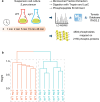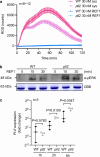Poltergeist-Like 2 (PLL2)-dependent activation of herbivore defence distinguishes systemin from other immune signalling pathways
- PMID: 40615605
- PMCID: PMC12283378
- DOI: 10.1038/s41477-025-02040-7
Poltergeist-Like 2 (PLL2)-dependent activation of herbivore defence distinguishes systemin from other immune signalling pathways
Abstract
Systemin, the first signalling peptide identified in plants, mediates induced resistance against insect herbivores and necrotrophic pathogens in tomato1-3. Initially, systemin was conceived as a hormone-like, long-distance messenger that triggers systemic defence responses far from the site of insect attack. It was later found to rather act as a phytocytokine, amplifying the local wound response for the production of downstream signals that activate defence gene expression in distant tissues4. Systemin perception and signalling rely on the systemin receptor SYR15. However, the specifics of SYR1-dependent signalling and how systemin signalling differs from other immune signalling pathways remain largely unknown. Here we report that systemin activates the poltergeist-like phosphatase PLL2 in a SYR1-dependent manner. PLL2, in turn, regulates early systemin responses at the plasma membrane, including the rapid inhibition of proton pumps through dephosphorylation of their regulatory C-termini. PLL2 was found to be essential for downstream defence gene induction, ultimately contributing to insect resistance.
© 2025. The Author(s).
Conflict of interest statement
Competing interests: The authors declare no competing interests.
Figures












References
-
- Pearce, G., Strydom, D., Johnson, S. & Ryan, C. A. A polypeptide from tomato leaves induces wound-inducible proteinase inhibitor proteins. Science253, 895–898 (1991). - PubMed
-
- Schilmiller, A. L. & Howe, G. A. Systemic signaling in the wound response. Curr. Opin. Plant Biol.8, 369–377 (2005). - PubMed
-
- Wang, L. et al. The systemin receptor SYR1 enhances resistance of tomato against herbivorous insects. Nat. Plants4, 152–156 (2018). - PubMed
MeSH terms
Substances
Grants and funding
LinkOut - more resources
Full Text Sources

